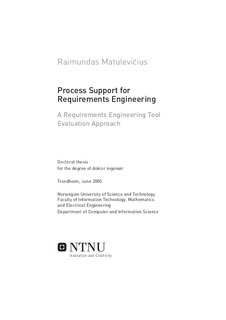| dc.contributor.author | Matulevičius, Raimundas | nb_NO |
| dc.date.accessioned | 2014-12-19T13:29:45Z | |
| dc.date.available | 2014-12-19T13:29:45Z | |
| dc.date.created | 2005-08-19 | nb_NO |
| dc.date.issued | 2005 | nb_NO |
| dc.identifier | 125659 | nb_NO |
| dc.identifier.isbn | 82-471-7170-8 | nb_NO |
| dc.identifier.uri | http://hdl.handle.net/11250/249810 | |
| dc.description.abstract | Requirements engineering (RE) tools are software tools which provide automated assistance during the RE process. However, the RE practice relies on office tools rather than RE-tools provided by various companies. Reasons for not using the RE-tools include financial causes. The part of the problem also lies in the difficulty to evaluate such tools before acquisition to support the RE process. Hence, to support the completeness and effectiveness of RE-tool evaluation, a sound framework providing methodological guidelines is needed.
This work proposes an RE-tool evaluation approach (R-TEA), which provides a systematic way of the RE-tool assessment using two evaluation frameworks. The framework for the functional RE-tool requirements consists of three dimensions: representation, agreement, and specification. The representation dimension deals with the degree of formality, where requirements are described using informal, semiformal and formal languages. The agreement dimension deals with the degree of agreement among project participants through communication means. The specification dimension deals with the degree of requirements understanding and completeness at a given time moment. The second framework categorises the non-functional RE-tool features to process, product, and external requirements. Process requirements characterise constraints placed upon the user’s work practice. Product requirements specify the desired qualitative characteristics of RE-tools. External requirements are derived from the user’s internal and external environment.
Both frameworks are applied to a specification exemplar which application initiates preparation of the requirements specification for the RE-tool selection. Assessment of the RE-tools’ compatibility to the specified RE-tool requirements is performed using different evaluation techniques. Decision about RE-tool selection is made after summarising all the assessment results.
A prototype tool is developed supporting the frameworks and R-TEA. The R-TEA method is tested in a number of case studies. The findings report on positive trends of the frameworks, prototype and the R-TEA method. | nb_NO |
| dc.language | eng | nb_NO |
| dc.publisher | Fakultet for informasjonsteknologi, matematikk og elektroteknikk | nb_NO |
| dc.relation.ispartofseries | Doktoravhandlinger ved NTNU, 1503-8181; 2005:142 | nb_NO |
| dc.subject | Informatics, computer and systems science | en_GB |
| dc.subject | Requirements engineering | en_GB |
| dc.subject | RE process support | en_GB |
| dc.subject | RE-tools | en_GB |
| dc.subject | Information Systems | en_GB |
| dc.subject | RE process improvement | en_GB |
| dc.subject | SOCIAL SCIENCES: Statistics, computer and systems science: Informatics, computer and systems science | en_GB |
| dc.title | Process Support for Requirements Engineering: A Requirements Engineering Tool Evaluation Approach | nb_NO |
| dc.type | Doctoral thesis | nb_NO |
| dc.source.pagenumber | 309 | nb_NO |
| dc.contributor.department | Norges teknisk-naturvitenskapelige universitet, Fakultet for informasjonsteknologi, matematikk og elektroteknikk | nb_NO |
| dc.description.degree | dr.ing. | nb_NO |
| dc.description.degree | dr.ing. | en_GB |
